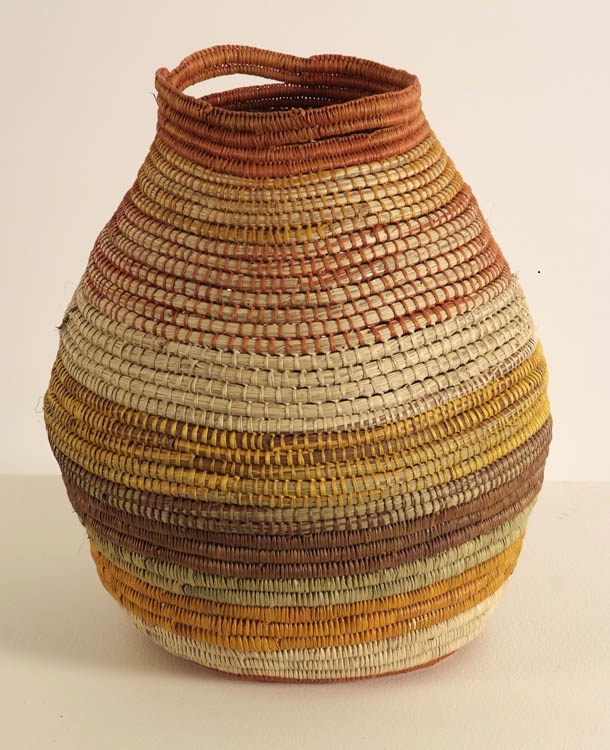There’s a matter that deserves your attention at Lawrence Wilson Art Gallery, says Jaimi Wright.
Getting to the heart of matter
17 September 2021
- Reading time • 5 minutesVisual Art
More like this
- Waves of influence span an ocean
- A walk with Tina Stefanou
- A blaze of glorious people
‘Matter’, various artists ·
Lawrence Wilson Art Gallery ·
If you like clever word play, Lawrence Wilson Art Gallery (LWAG) has a good one for you: what is matter, and why does it matter?
Art is so often about the finished product; the audience isn’t often privy to the creation of the artwork, the meticulous choice of materials involved, and what that process means. Drawn from the Cruthers Collection – Australia’s largest specialist collection of Women’s Art – by curator Lee Kinsella, LWAG’s latest exhibition “Matter” places materials, and the processes used to make an artwork, centre stage.
Established by collector and patron Lady Sheila Cruthers in 1974, the Cruthers Collection features female Australian artists from the late nineteenth-century to the present day. In “Matter” – which is presented as a satellite exhibition of the Indian Ocean Craft Triennial (IOTA21) – Kinsella re-examines this rich tapestry of Australian women’s art history, to explore female perspectives and rituals expressed through the process of making art and craft works.
On entering the exhibition, an aerial view of salt lakes in the Kimberley – by renowned West Australian artist Carol Rudyard – is eye-catching. Painted in 1970, Rudyard’s untitled two-dimensional acrylic work evokes a sense of the instability and liminality of matter through its choice of subject, transitioning shapes and abstracted colour palette.
In Glenys Hodgeman’s 2000 work, Death is never out of style (pictured top, centre), it’s the human body that is represented as matter, both ideologically and physically. Here, a burial shroud is the canvas. Down its centre a series of organs is embroidered above the phrase “le mort est jamais démodé” (death never goes out of fashion), all stitched in blood red thread. In her choice of materials, Hodgeman’s repurposed shroud serves as a simple but chilling memento mori; we are nothing but a series of parts, and death comes for us all.

The ritualistic nature of craft is explored through the artworks of Ruby Brilliant, and Mary Ganganiwuy and Julieanne Gitjpulu. Brilliant’s wall hanging, A cup of tea, a Bex and a good lie down (1995), combines the physical ritual of knitting, the emotional rituals we use to relax, and historical Australiana to take a gently tongue-in-cheek look at our culture of comfort.
Ganganiwuy and Gitjpulu’s handwoven baskets, both titled Basket (2004), embody the significance of weaving to their Yolngu heritage. The natural fibres are precisely handwoven in beautiful, warm, earthy tones; the baskets are not only examples of incredible craftsmanship, but celebrations of the traditions of Yolngu women.
“Matter” also includes a series of works from the Badimaya woman Julie Dowling, and her re-contextualisation of colonial history. In Melbin (1999) Dowling depicts her great-great-Grandmother Melbin who was taken to England from her ancestral lands to be exhibited as a curiosity in the late nineteenth-century. Melbin sits in a Victorian dress as part of a Renaissance-style portrait, with a halo at her head containing motifs of ships and shackles. In repurposing the medium of European portraiture to tell First Nations stories, Dowling asks her audience to consider how history is written, which histories matter to us, and what First Nations stories are yet to be told.
The curation of great art collections should not remain stagnant; they deserve to be re-examined and reconstructed to generate new insights and perspectives. In her curation of this exhibition Lee Kinsella has reimagined the Cruthers Collection to focus on its material foundations, and in the process, has created something fresh, stimulating and remarkable.
In short, this matter deserves your attention.
‘Matter’ continues at Lawrence Wilson Art Gallery until 27 November 2021.
Pictured top L-R:
Maxxi Minaxi May, ‘Deconstructing beauty’, 2003, plastic dolls, paint, foamcore and wood, 105 x 21 x 5.7 cm, Cruthers Collection of Women’s Art, The University of Western Australia. Copyright and courtesy of the artist.
Glenys Hodgeman’s ‘Death is never out of style’, 2000, cotton embroidery on paper burial shroud, 194 x 157 cm, © courtesy of the artist
Lilla Lowe, ‘Apples and apple blossoms’, 1896, oil on cedar panel, 90 x 26.5 cm, Cruthers Collection of Women’s Art, The University of Western Australia.
Like what you're reading? Support Seesaw.





